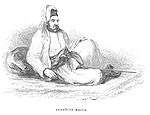Sharif of Mecca
The Sharif of Mecca (Arabic: شريف مكة, Sharīf Makkah) or Hejaz (Arabic: شريف الحجاز, Sharīf al-Ḥijāz) was the title of the leader of the Sharifate of Mecca, traditional steward of the holy cities of Mecca and Medina. The term sharif means "noble" in Arabic and is used to describe the descendants of Prophet Muhammad's grandson al-Hassan ibn Ali.
The Sharif was charged with protecting the cities and their environs and ensuring the safety of pilgrims performing the Hajj. The title is sometimes spelled Sheriff or Sherif, with the latter variant used, for example, by T. E. Lawrence in Seven Pillars of Wisdom. The common law political and legal office of sheriff found in some anglophone countries is unrelated.
The office of the Sharifate of Mecca dates back to the late Abbasid era. Since 1201, the Sharifate was held by a member of the Hawashim clan, not to be confused with the larger clan of Banu Hashim to which all Sharifs claim descent. Descendants of this family continued to hold the position until the 20th century on behalf of various Muslim powers including the Ayyubids and the Mamelukes. In 1517, the Sharif acknowledged the supremacy of the Ottoman Caliph, but maintained a great degree of local autonomy. During the Ottoman era, the Sharifate expanded its authority northwards to include Medina, and southwards to the frontiers of 'Asir, and regularly raided Nejd.
The Sharifate came to an end shortly after the reign of Hussein bin Ali, ruled from 1908, who rebelled against the Ottoman rule during the Arab Revolt of 1916. After the defeat of the Ottoman Empire in 1918 and its subsequent dissolution in 1923, Hussein declared himself Caliph. The British granted control over the newly formed states of Iraq and Transjordan to his sons Faisal and Abdullah. In 1924, however, in the face of increasing attacks by Ibn Saud, Hussein abdicated his secular titles to his eldest son, Ali bin Hussein, who was to become the last Grand Sharif. At the end of 1925, Ibn Saud conquered the Hejaz and expelled the Hashemites. The House of Saud has ruled the holy cities and the Hajj since that time.[1]
List of Sharifs of Mecca (967–1925)
During the Fatimid Dynasty (967–1101)

- Taimon (The fox) (967–980)
- Sharif Essa (980–994)
- Sharif Abu'l-Futuh (994–1039), briefly anti-Caliph in 1012
- Sharif Shukrul-Din (1039–1061)
- Abul-Hashim ibn Muhammed (1061–1094)
- Ibn Abul-Hashim Al-Thalab (1094–1101)
During the Ayyubid Empire (1201–1254)

- Qatada ibn Idris al-Hasani al-Alawi (1201–1220): Killed at age 90 by his son
- Hasan ibn Qatada al-Hasani al-Alawi (1220–1241): Al-Zahir Baibers ruler of Egypt sends a prince to collect Zakat from the area including the surrounding bedouins
- Al-Hassan abul-Saad (1241–1254)
During the Mamluk Empire (1254–1517)

- Muhammed abul-Nubaj (1254–1301): First Mamluk Sharif after the fall of Ayyubid Empire
- Rumaitha Abul-Rada (1301–1346)
- Aljan Abul-Sarjah (1346–1375)
- Al-Hassan II (1394–1425)
- Barakat I (1425–1455)
- Malik ul-Adil ibn Muhammed ibn Barakat (1455–1497)
- Barakat II bin Muhammed (Barakat Efendi) (1497–1525): Built the first Walls of Jeddah by order of Al-Ashraf Qansuh al-Ghawri
During the Ottoman Empire (1517–1917)


- Barakat Efendi (1497–1525): First Ottoman Sharif; Hejaz became an Ottoman state after the fall of Cairo to Sultan Selim I.
- Muhammed Abul-Nubaj bin Barakat (1525–1583): Rebuilt the walls of Jeddah in 1525 following the victory over Portuguese Armada in the Red Sea
- Al-Hassan bin Muhammad Abul-Nubaj (1583–1601)
- Idris bin Al-Hassan (1601–1610)
- Muhsin bin Hussein (1610–1628)
- Ahmed bin Talib Al-Hasan (1628–1629)
- Masud bin Idris (Masut Efendi) (1629–1630)
- Abdullah bin Hassan (1630–1631)
- Zeid bin Muhsin (1631–1666)
- Saad bin Zeid (1666–1667)
- Muhsin bin Ahmed (1667–1668)
- Saad bin Zeid (1668–1670)
- Homud bin Abdullah bin Al-Hasan (1670–1670)
- Saad bin Zeid (1670–1671)
- Barakat bin Muhammed (1672–1682)
- Said bin Barakat (1682–1683)
- Ibrahim bin Muhammed (1683–1684)
- Ahmed bin Zeid (1684–1688)
- Ahmed bin Ghalib (1688–1689)
- Muhsin bin Ahmed (1689–1691)
- Said bin Saad (1691–1693)
- Saad bin Zeid (1693–1694)
- Abdullah bin Hashim (1694–1694)
- Saad bin Zeid (1694–1702)
- Said bin Saad (1702–1704)
- Abdulmuhsin bin Ahmad (1704–1704)
- Abdulkarim bin Muhammed (1704–1705)
- Said bin Saad (1705–1705)
- Abdulkarim bin Muhammed (1705–1711)
- Said bin Saad (1711–1717)
- Abdullah bin Said (1717–1718)
- Ali bin Said (1718–1718)
- Yahya bin Barakaat (1718–1719)
- Mubarak bin Ahmad (1719–1722)
- Barakaat bin Yahya (1722–1723)
- Mubarak bin Ahmad (1723–1724)
- Abdullah bin Said (1724–1731)
- Muhammed bin Abdullah (1731–1732)
- Masud bin Said (1732–1733)
- Muhammed bin Abdullah (1733–1734)
- Masud bin Said (1734–1759)
- Jafar bin Said (1759–1760)
- Musa'ed bin Said (1760–1770)
- Ahmad bin Said (1770–1770)
- Abdullah bin Hussein (1770–1773)
- Surur ibn Musa'id (1773–1788)
- Abdulmuin bin Musa'ed (1788–1788): Appointed by Saud ibn Abdul Aziz ibn Muhammad ibn Saud, the ruler of Dir'iyyah
- Ghalib Efendi bin Musa'ed (1788–1803)
- Yahya bin Surour (1803–1813): Jailed in Constantinople during the Ottoman–Saudi War
- Ghalib Efendi bin Musa'ed (1813–1827)
- Abdulmutalib bin Ghalib (1827–1827)
- Muhammed bin Abdulmuin (1827–1851)
- Abdulmutalib bin Ghalib (1851–1856)
- Muhammed bin Abdulmuin (1856–1858)
- Abdullah Kamil Pasha (1858–1877)
- Hussein bin Muhammed (1877–1880)
- Abdulmutalib bin Ghalib (1880–1882)
- Aun Al-Rafiq Pasha (1882–1905)
- Ali Abdullah Pasha (1905–1908)
- Hussein bin Ali Pasha (1908–1916) (later King Hussein)
- Ali Haidar Pasha (1916–1917)
During the Kingdom of Hejaz (1916–1925)

- King Hussein bin Ali (1916–1924) (previously Hussein Pasha)
- King Ali bin Hussein (1924–1925)
See also
- Custodian of the Two Holy Mosques
- Sharifate of Mecca
- Hejaz Vilayet
- Kingdom of Hejaz
- Sharifian Caliphate
- Battle of Mecca (1916)
- Battle of Mecca (1924)
- Siege of Medina
- List of Caliphs
- List of Sunni Muslim dynasties